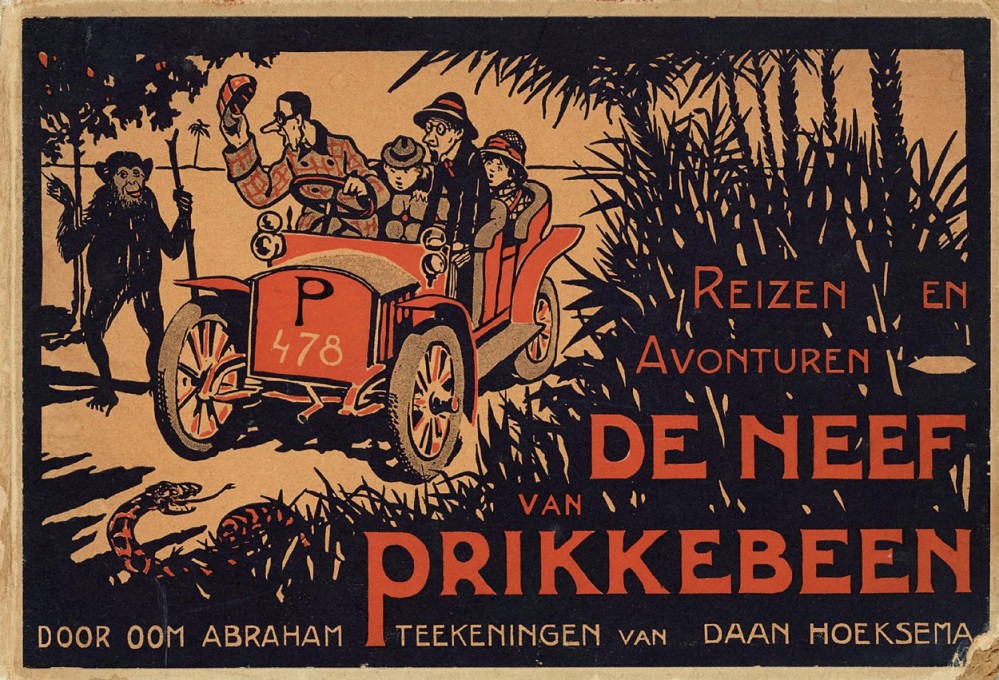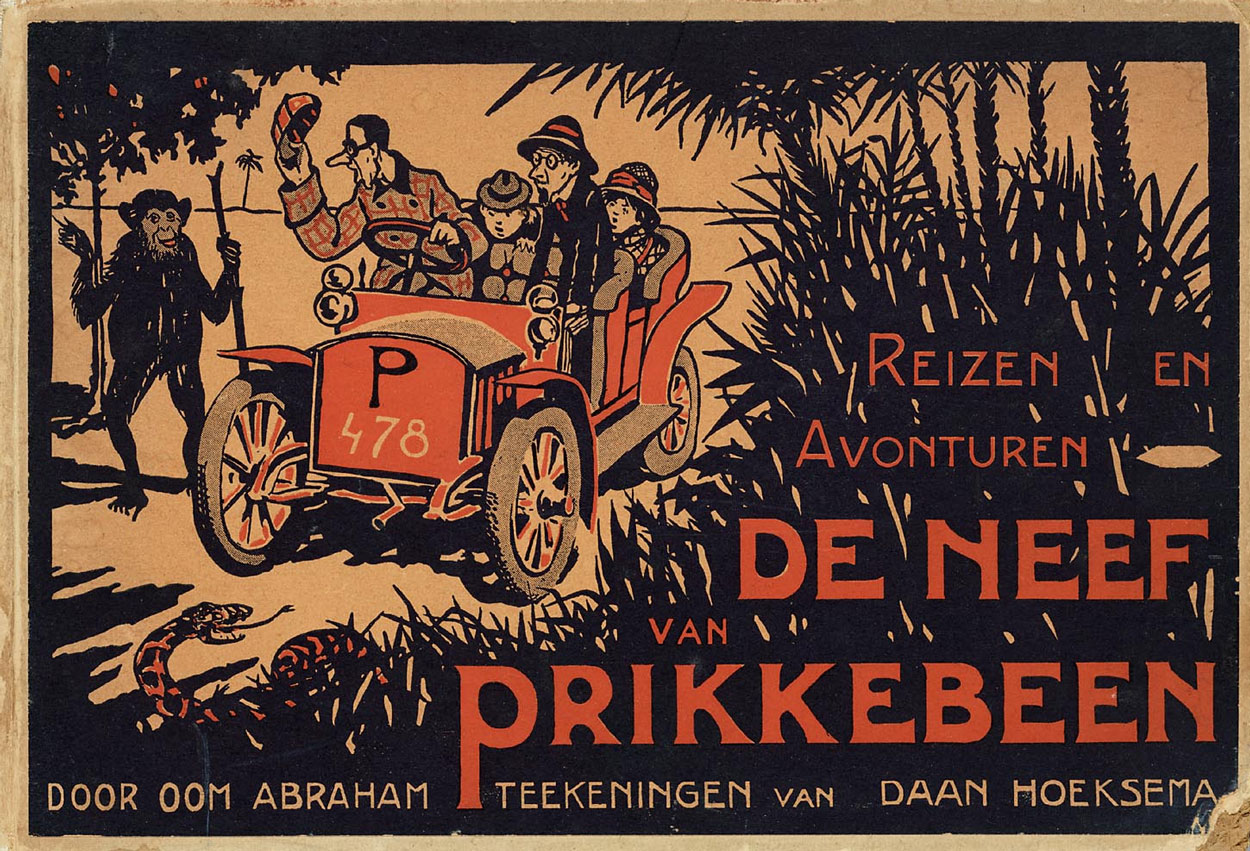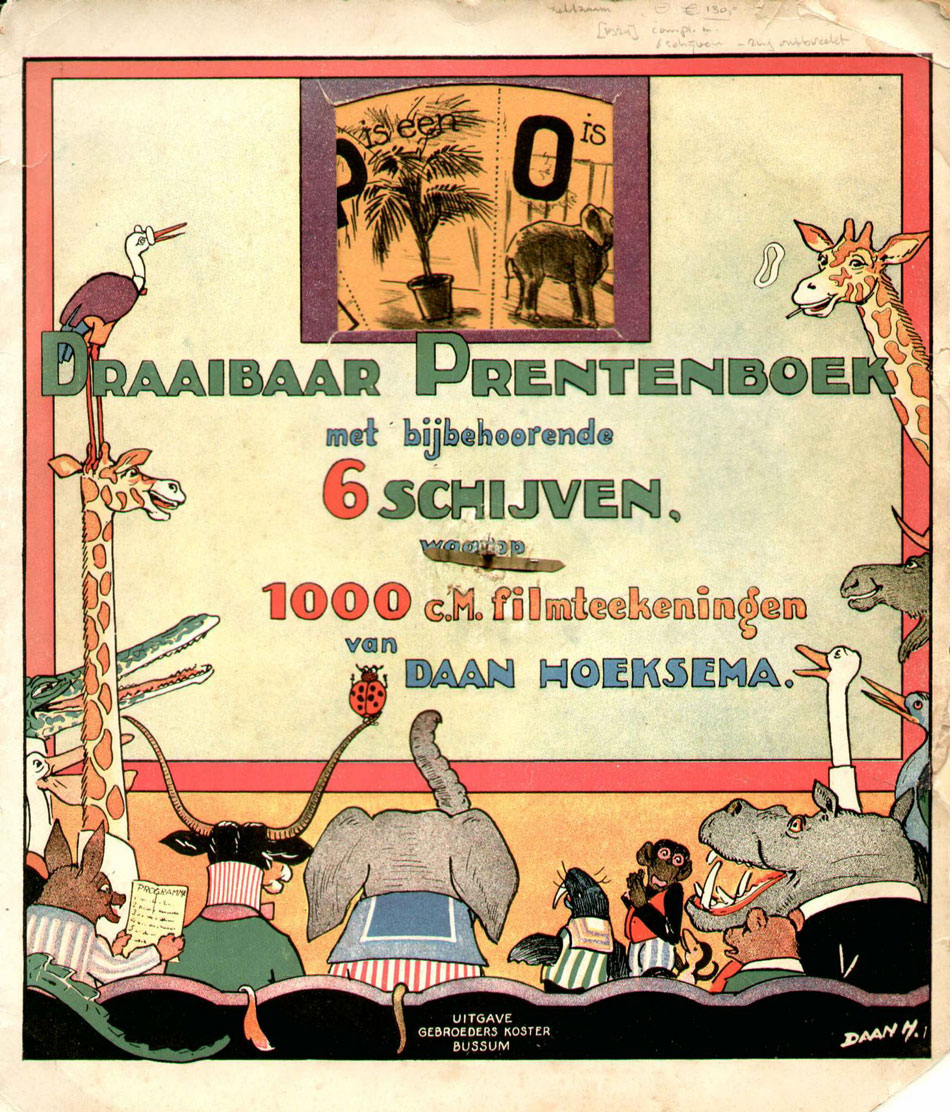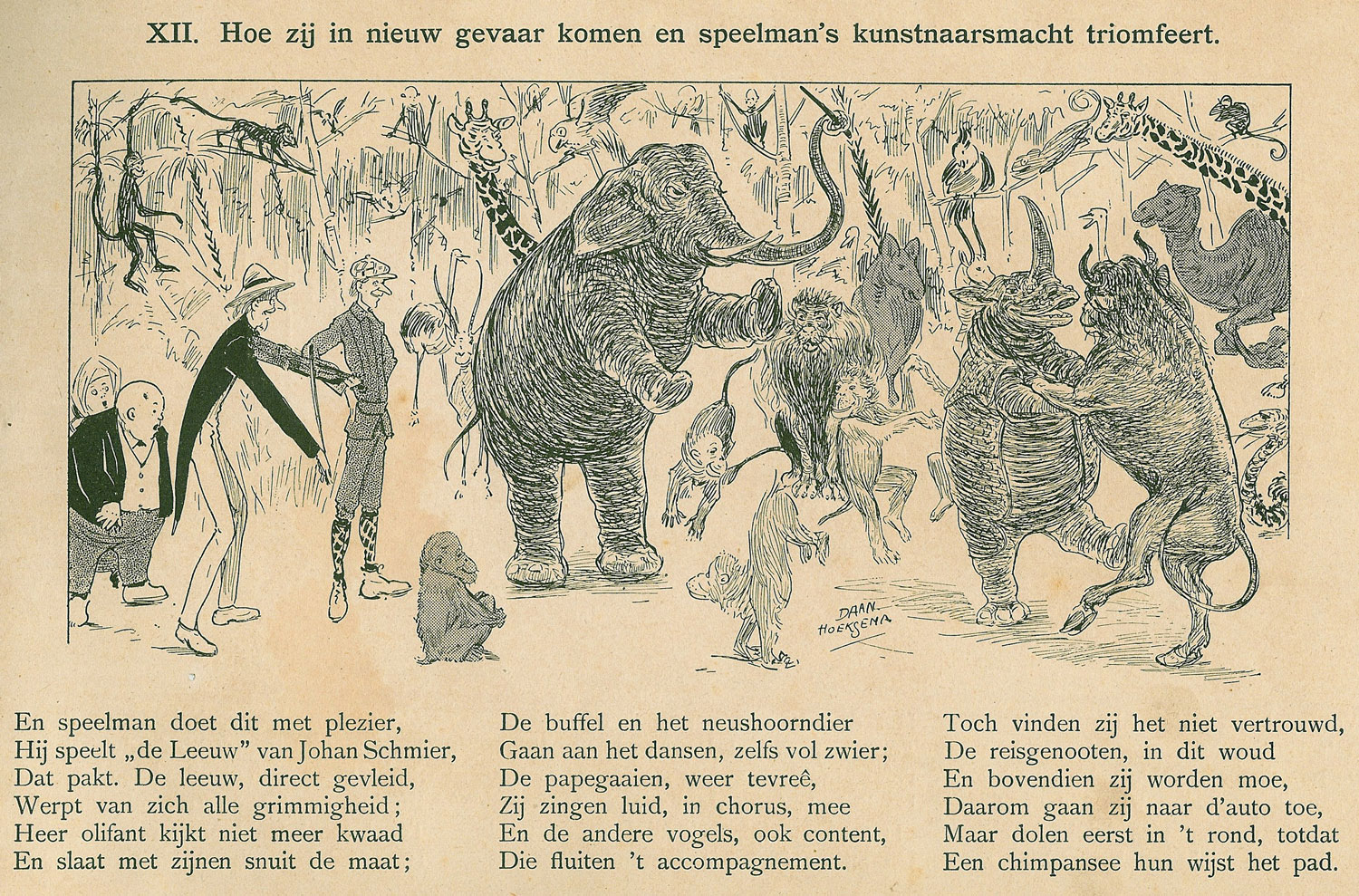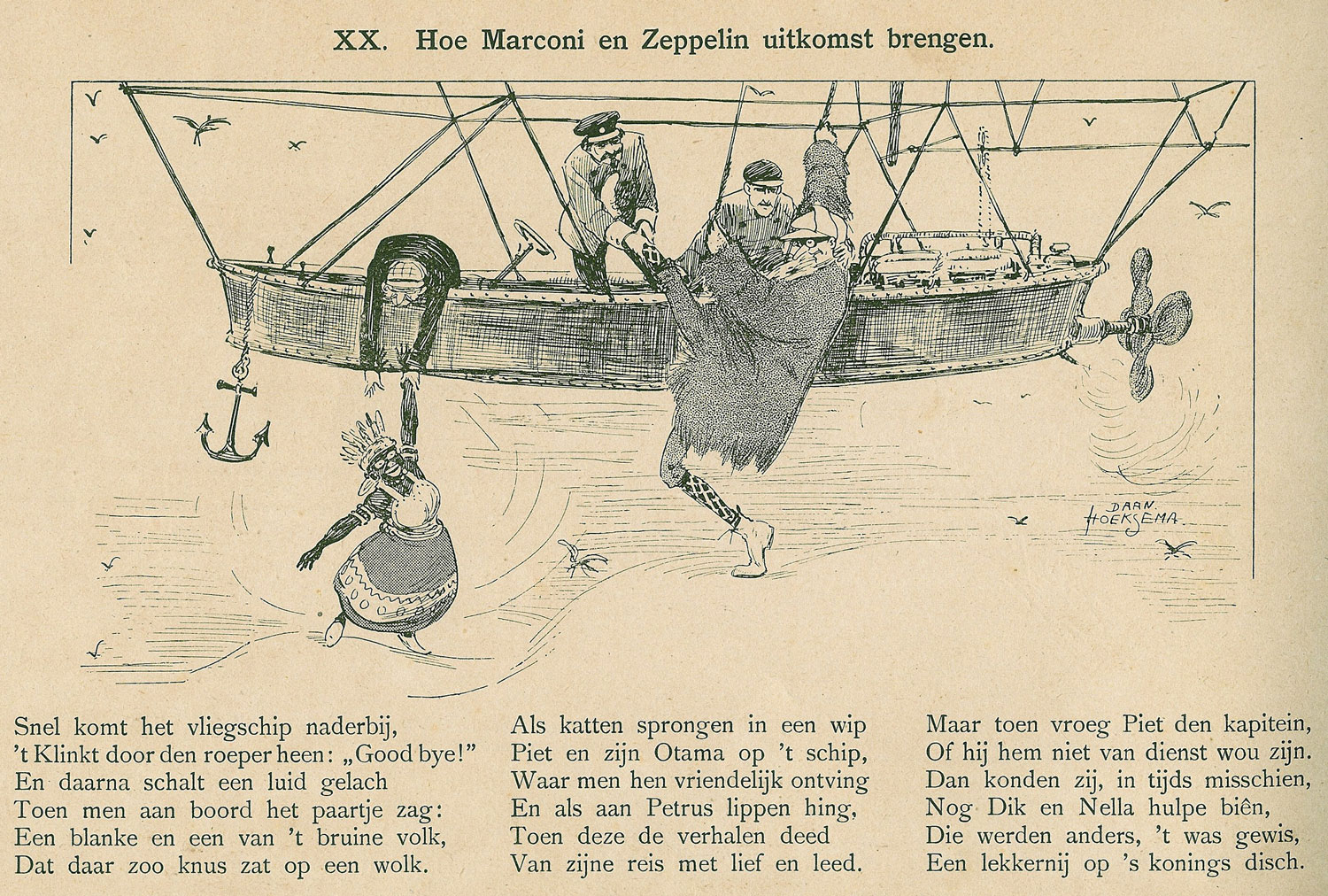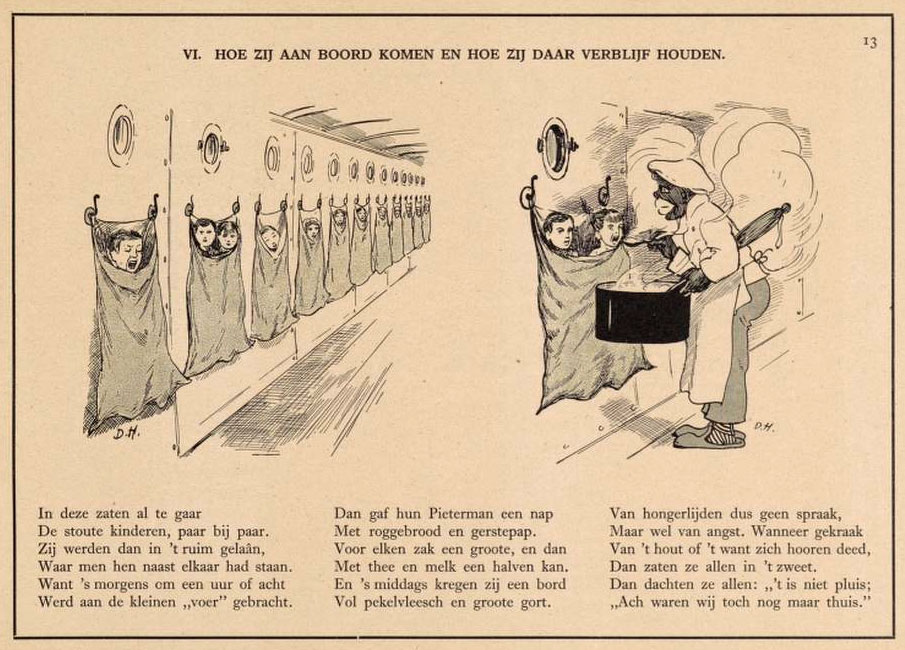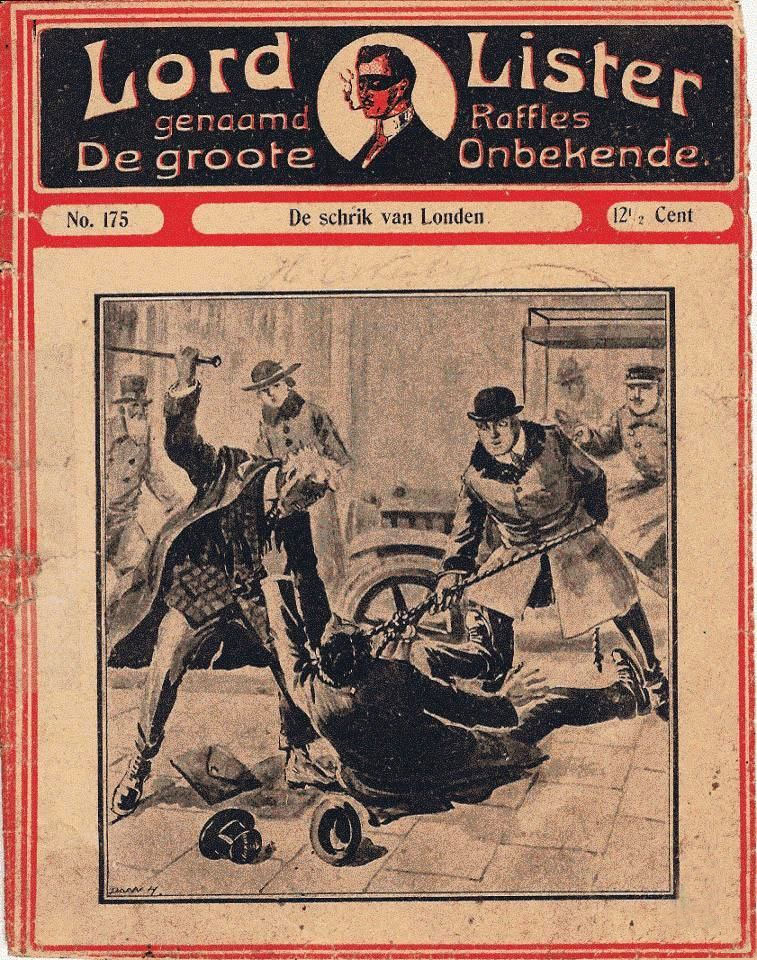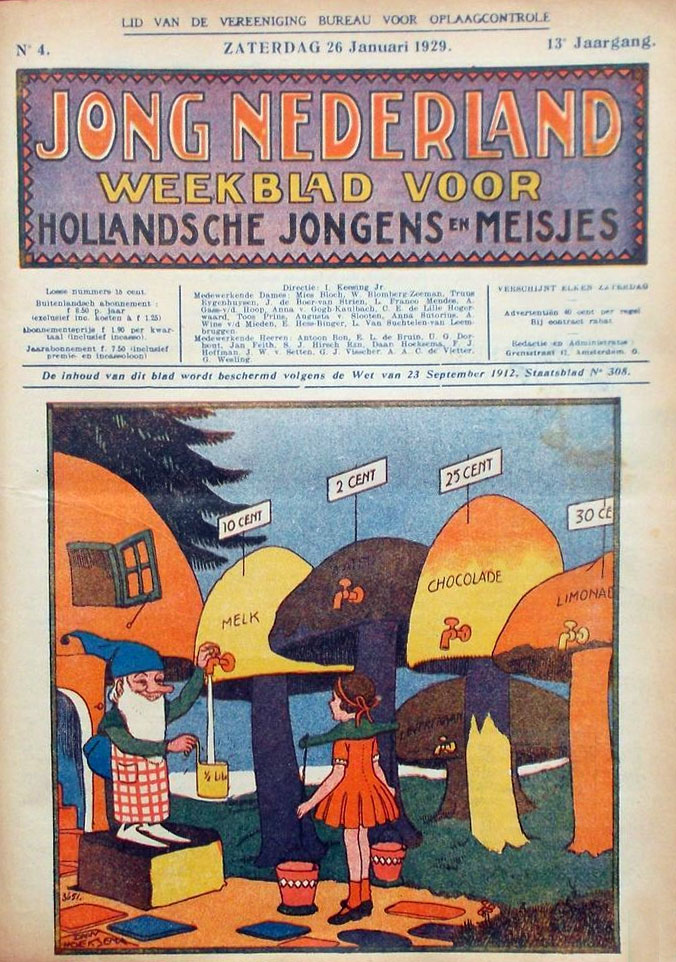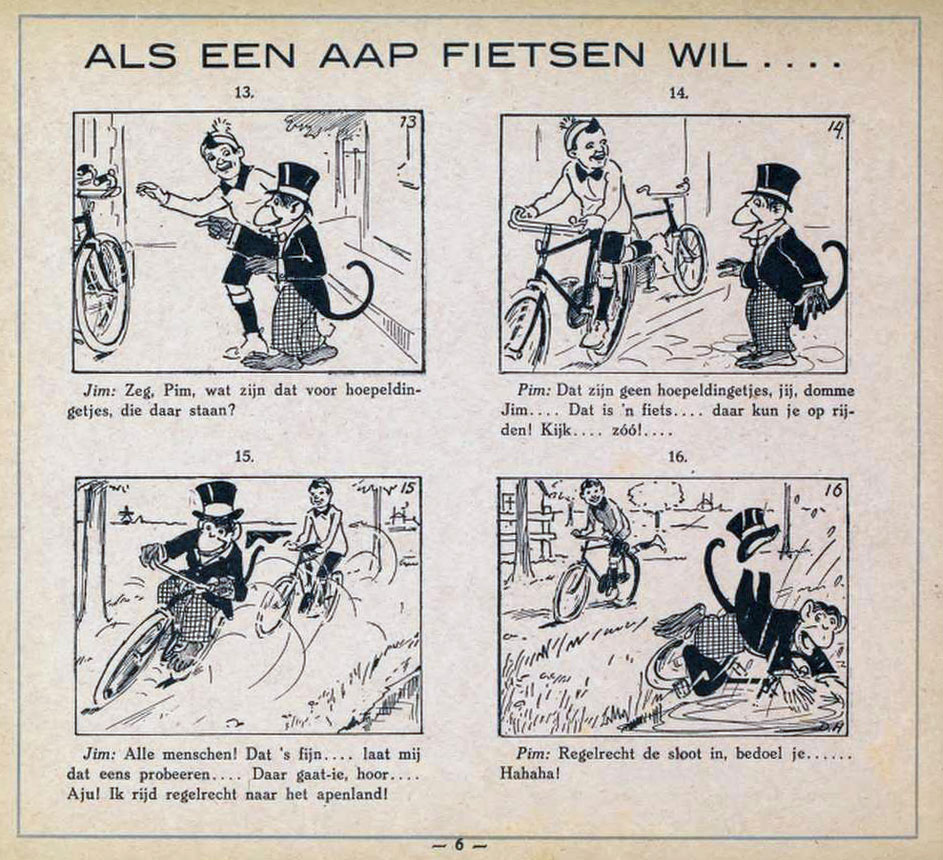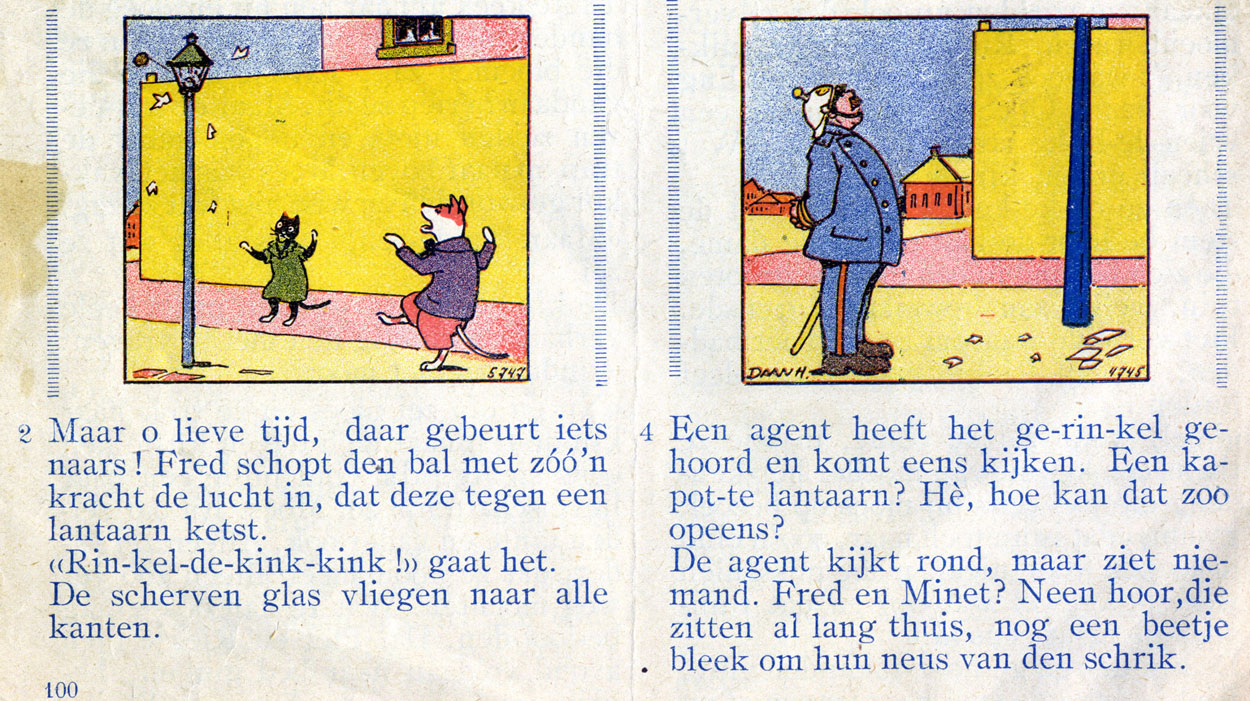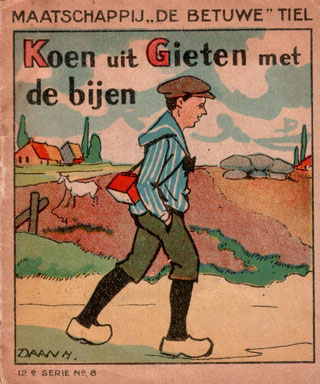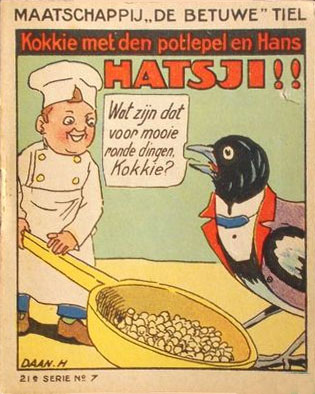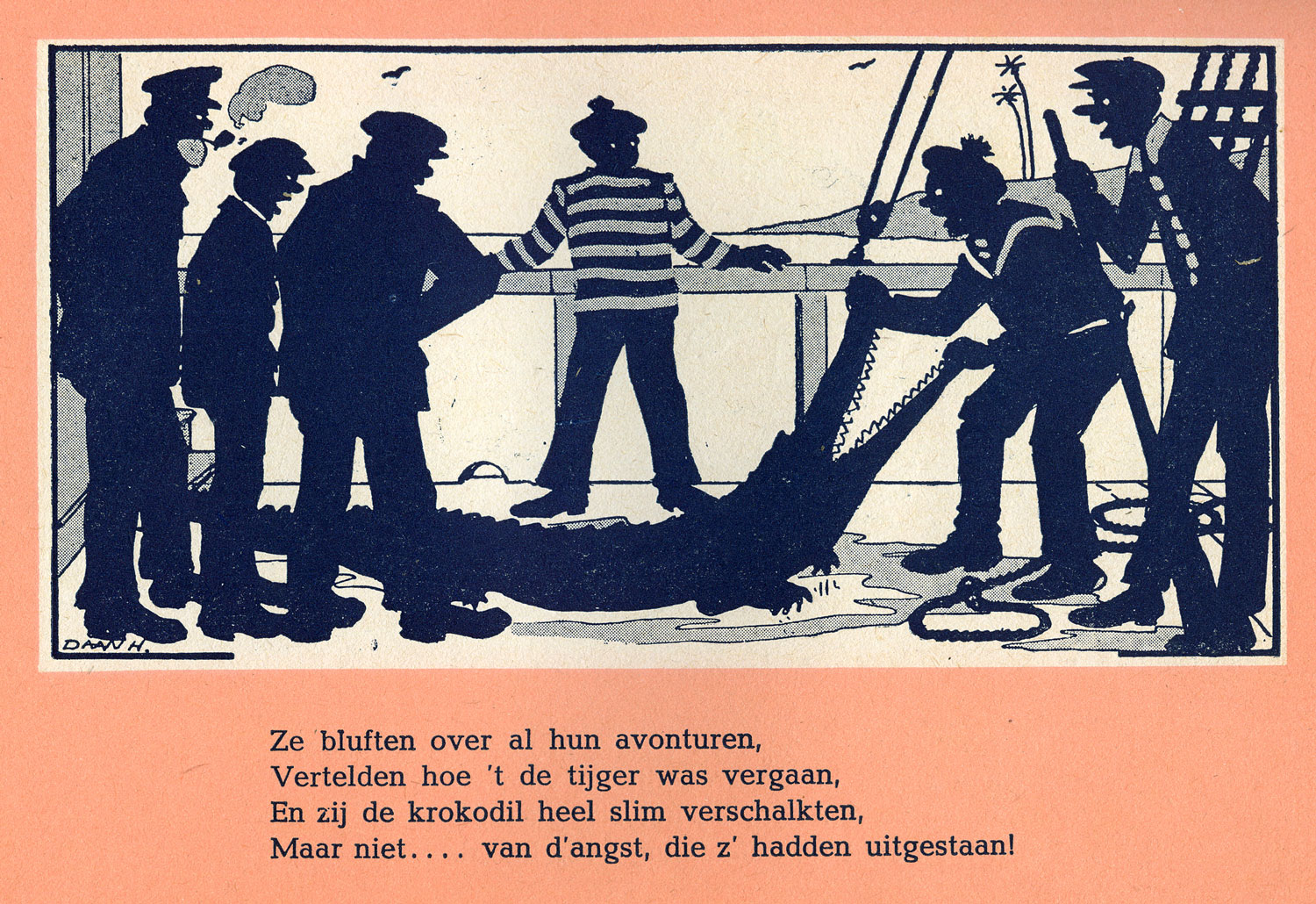'De Neef van Prikkebeen' (1909).
Daan Hoeksema was a Dutch children's book illustrator and designer for book bindings and advertisements, as well as a national comics pioneer. While sequential narratives had been used before in the Netherlands, Hoeksema's 'De Neef van Prikkebeen' (1909) is regarded as the first locally-produced Dutch comic book with an ongoing storyline and one notable recurring character. Hoeksema continued to create comic-like picture stories for other book publications by publisher Koster as well as regular features in magazines such as Jong Nederland and Na De School. As an advertising artist, he was notable as the first illustrator to draw Flipje, the fruity mascot of jam factory De Betuwe.
Early life
Daniël Hoeksema was born in 1879 in Oldekerk, a small town in the province of Groningen. Shortly afterwards, the family moved to Roden, a town 13 kilometers southwards, located in the province of Drenthe. In 1882, father Freerk Hoeksema (1845-1921) started his own bakery in the Heerestraat. Initially destined to follow in his father's footsteps, Daniël began helping his father in the bakery at an early age. To learn the trade, he had an apprenticeship with a bakery in Groningen, where he also took evening drawing classes at the Academy Minerva. Aware of his talents and ambitions, father Hoeksema supported his son in further pursuing an artistic education. Several of the other Hoeksema siblings showed creative talents too. Daniël's younger brother Arend entertained his fellow townspeople with his funny inventions and crafts, for instance the self-made lifelike cardboard hares he hid in the fields to fool the local hunters.
In 1901, Daan Hoeksema moved to Amsterdam, where he spent three years studying at the Arts and Crafts School ("Kunstnijverheidsschool"), the future Rietveld Academy. In 1903 and 1904, he additionally took evening classes at the Amsterdam Academy of Fine Arts. In 1913, he married his second wife, Nel Tollenaar.
"Rotating picture book" by Daan Hoeksema (1924).
Children's activity work
Graduated in 1904, Hoeksema began working as a fulltime illustrator and graphic designer. One of his main clients was the Bussum-based publishing firm Gebroeders Koster, for which he did most of his work for children. Generally referred to as "Vriend Daan" ("Friend Daan"), while signing with "Daan H." or only his initials, Hoeksema created children's activity material, picture postcards and books with illustrated stories. His activity work included coloring pictures and instruction booklets for cutting, pasting and embroidering. For the 1913 series 'Bont en Blauw', Hoeksema created folders with cuttings, construction cardboards and other work material to create picturesque wall charts. Other series contained paper construction sets to build palaces ('Paleizen der Jeugd', 1913) and figurines for collages ('Teekenen zonder stift', 1932). For the narratives in his children's handicraft work, Hoeksema relied on traditional rhymes and verses. His 1925 book 'De Leukste Versjes Uit De Ouwe Doos Met Krabbels Van Vriend Daan' was a collection of classic children's rhymes with simply constructed illustrations for toddlers to color. In 'De Aloude Baker- en Kinderrijmen in Hokus Pokus Pas, 32 Tooverplaatjes van Daan Hoeksema', children could conjure up hidden images from the white glossy paper by scratching over them with a colored pencil. Similar stories with "magically" appearing images appeared in the four-volume series 'Met Daan Hoeksema in Tooverland' (1915).
Characterized by a strong sense of humor, with appearances of comical clowns, dancing animals and playful dolls, many of Hoeksema's booklets were reprinted regularly. And even though the illustrator was known to be a modest man, his name became well-known as it was featured prominently in book titles such as 'Wat Daan Hoeksema Als Kleuter Knutselde: Naar Gegevens Uit Zijn Oude Plakschriften' ("What Daan Hoeksema Made As A Toddler: Based On Information From His Old Notebooks", 1927).
'De Neef van Prikkebeen' (1909).
De neef van Prikkebeen
In addition to his handicraft creations, Daan Hoeksema made several children's picture books for the publisher Gebroeders Koster. Making use of sequential illustrations and a landscape format, they can be considered early Dutch comic books. Underneath the images, dialogues and descriptions appear in text captions, written in rhyme by "Oom Abraham", a pen name for J.A.C. Oosterbeek.
Hoeksema's first and most notable proto-comic was 'De Neef van Prikkebeen - Reizen en Avonturen' ("Prikkebeen's Nephew - Travels and Adventures", 1909). With a couple of detours, the story was a sequel to 'Histoire de M. Cryptogame' by the Swiss comics pioneer Rodolphe Töpffer. First published in 1830, Töpffer's tale was an illustrated farce about an obsessive butterfly collector and his fiancé. After its initial publication in France and Switzerland, the story received several international editions, sometimes with a different text. In Germany, Julius Kell created a new narrative to go with Töpffer's drawings. This German version was the basis for the 1858 Dutch translation by J.J.A. Goeverneur, who in turn also edited and censored certain elements. Published in the Netherlands as 'Reizen en Avonturen van Mijnheer Prikkebeen', the Goeverneur version has become an often-reprinted classic of Dutch children's literature, as well as the first comic book published in the country.
'De Neef van Prikkebeen' (1909).
In Hoeksema's follow-up, the elderly Prikkebeen is on his deathbed, declaring that his wife Pieternel will inherit all his fortune and has to remarry with his best friend Dikkie. But then Prikkebeen's nephew Piet shows up, also interested in the inheritance. His claim is refused, but as a peace-offering, he is allowed to accompany the newlyweds on their honeymoon. What follows is a farcical tale in the same style as Töpffer's original. During their trip, the threesome shipwrecks, ends up in the stomach of a whale and eventually arrives in Africa, where the local population is presented as naïve cannibals and other nowadays offensive racial stereotypes for the time. At the end of the story, Piet hooks up with Otama, the daughter of the tribe chief, with whom he flies away on a raincloud before the couple is finally brought home by a zeppelin. Living in a villa in the Netherlands, the mixed couple has twelve children in all sorts of colors, much to Piet's amusement, as he "loves to see some variation".
After its first publication in 1909, 'De Neef van Prikkebeen' was reprinted several times. In the 1930s, both Peter Lutz and Jac. A. Hazelaar made more Dutch comics inspired by the Prikkebeen story, both presenting the character's son: 'Avonturen van Prikkebeen Junior' and 'De Zoon van Prikkebeen'. The Goeverneur adaptation of the original Töppfer story was reworked in the 1940s with new illustrations by Ben Mohr.
'Poppedijntje en Hare Ongehoorde Lotgevallen' (early 1920s).
Picture books
During the 1910s and 1920s, Hoeksema continued to produce picture stories for the Koster publishing house. One year after 'Prikkebeen', Hoeksema and "Oom Abraham" created 'Tijl XI, De Laatste Der Uilenspiegels' (1910), starring a cousin of the folkloric character Till Eulenspiegel. In 1915, the same creators made 'Mee In Den Zak: De Ernstige Lotgevallen van Grietje en Pietje'. It tied in with the annual Dutch Sinterklaas festivities, during which Saint Nicolas and his helper (Black) Pete visit the Netherlands to bring gifts to the youth. Children who have been naughty however, are put in Pete's bag and taken back home to Spain. 'Mee In Den Zak' features the story of the mischievous children Grietje and Pietje, who have to undergo this punishment. In the early 1920s, Hoeksema worked with writer P.A.E. Oosterhoff on 'Poppedijntje en Hare Ongehoorde Lotgevallen', a picture book about the adventures of a group of puppets. With the same writer, Hoeksema additionally created the six-volume series 'Daan Hoeksma's Gebonden Prenten, Met Versjes van P.A.E. Oosterhoff', containing the titles 'De Avonturen van een Aapje op Stap', 'Het Maanmannetje; 'n Wondere Maanreize', 'Maar een Droom Vliegavonturen', 'Smul en Snoeper in Luilekkerland', 'De Springende Springer' and 'De Verkeerde Wereld'.
'Mee In Den Zak: De Ernstige Lotgevallen van Grietje en Pietje' (1915).
Between 1925 and 1927, Hoeksema created four volumes of 'De Struwelpetertjes uit Daan Hoeksema's teekenstift', taking inspiration from the 19th-century German children's book 'Der Struwwelpeter' by Dr. Heinrich Hoffmann. Each installment contained two stories. In the first volume, Hoeksema made a new version of Hoffmann's original tale 'Piet De Smeerpoets', about a boy who never washes himself, causing his hair and nails to grow to enormous lengths within a few days. Hoeksema continued by adapting Hoffmann's other moralistic tales, including 'Die Geschichte von dem wilden Jäger' ('De Wilde Jager') and 'Suppen-Kaspar' ('Soep Hein'). For the series 'Uurtjes Die Wij Nooit Vergeten' ("Hours We'll Never Forget"), Hoeksema illustrated 'Jan de Berenleider' (1927) and 'Karel Kuifkop' (1927), two stories in rhyme by Clinge Doorenbos. The collection 'Op het Witte Doek', also known as '"Zwartjes" van Daan Hoeksema', contained shadow play stories by Marian Hesper-Sint with silhouette drawings by Daan Hoeksema.
Cover illustrations for Lord Lister issue #117 (1917) and Jong Nederland issue #4 of 26 January 1929.
Magazine work
On top of his work for children's books, Hoeksema was a prominent artist for magazines. Already in the early stages of his career, he made cartoons and drawings for the satirical weekly De Ware Jacob. Between 1915 and 1917, he created 70 cover illustrations for the pulpy detective novel magazine series about 'Lord Lister', published by Eichler. Among the other illustrators for this series were Roloff and Jan Wiegman. Among his other illustration work during this period was for historical tales and adaptations of classic literature in the low-budget storybook collection 'Jacob van Campen's Jongens- en Meisjesbibliotheek'.
'De Vroolijke Avonturen van de Twee Kwaje Apen Pimmy en Jimmy' (from 1930s book publication).
From 1916 on, Hoeksema was the main illustrator for Jong Nederland, a new classy weekly magazine for children, published by Keesing. His drawings also appeared in the magazine's Flemish edition Na De School, which had a nearly identical content. Hoeksema provided all the cover illustrations, as well as several illustrated features, such as the largely pantomime picture story series 'De Wekelijkse Film' and the cartoon section 'Grappige Prentjes voor Meisjes en Ventjes'. From 1922 on, he drew several serials of 'De Vroolijke Avonturen van de Twee Kwaje Apen Pimmy en Jimmy', a comic serial about the mischievous adventures of a boy and a monkey, with text captions in verse by I. Keesing Jr. In 1930 and 1931, Hoeksema also drew the text comic adventures of 'Fred en Minet', starring a dog and cat couple. In 1932, Jong Nederland was absorbed by the bi-weekly Zonneschijn, for which Daan Hoeksema drew the comic 'Dissy en Gemsy', about an anthropomorphic lizard and chamois. Fred and Minet also continued their adventures in Zonneschijn, but by then was drawn by Frans Meijer.
Advertising artist
By 1910, Hoeksema was also active as an advertising illustrator, at the time a relatively new profession in the Netherlands. His art appeared on advertisements for Blookers and De Gruyter cocoa, Philips light bulbs, Pelikan ink, Bussink Deventer Koek, De Klok soap and the bicycle factories Germaan, Union and Simplex. Also in his occupation as commercial artist, Hoeksema was well-known for his children's picture stories, which appeared in give-away or collectible booklets. During the mid-1920s, Hoeksema made six booklets with 'De Avonturen van Flip en Flap' for Douwe Egberts coffee. These stories about two adventurous dogs were told as a text story with two identical illustrations per page: the top one in color, the bottom one for the young readers to color for themselves.
Advertising art: De Betuwe
From 1924 until well into the 1930s, Daan Hoeksema was most notably an illustrator of small promotional story booklets for jam factory De Betuwe. Since the 1920s, the company began its long tradition of such publications, starting with a series of eight fairy-tale themed books, illustrated by V. M. George. By the time De Betuwe launched its second collection of picture story books - 33 series of eight issues - Daan Hoeksema was their most prominent illustrator, although some installments were illustrated by Pol Dom or Jan Lutz. During a period of over ten years, Hoeksema illustrated dozens of booklets, featuring a short story of four pages, followed by an advertisement for one of De Betuwe's products. Several of them featured one-time creations, but eventually Hoeksema began using regular characters for these stories, for instance the piglets 'Knar en Knorrie Biggie'. On several occasions, Hoeksema used a team-up of a human lead with an anthropomorphic animal character, for instance the man-and-dog duo 'Ton en Does' and 'Kokkie met den Potlepel en Hans', a tiny human chef and a waiter bird. Hoeksema's final booklets were about 'Flip en zijn Vrindje Kangoe', featuring a black boy and his kangaroo friend.
Advertising booklets for De Betuwe by Daan Hoeksema.
Coincidentally, Hoeksema was also the first artist to draw De Betuwe's fruit figure mascot Flipje in a comic story, although not with an active role. Graphically designed by the Van Aften advertising agency, the Flipje character - a jolly man with a raspberry body and chef's hat - first appeared as a drawing on a wall in one of Hoeksema's 1935 booklets. In that year, De Betuwe began producing booklets with Flipje in a starring role, drawn by Henk Rotgans. After that, Eelco ten Harmsen van der Beek became the artist of the 'Flipje van Tiel' stories, a tradition that has continued for many decades, up until the 21st century 'Flipje' revival by artist Arie van Vliet.
Death
In January 1935, Daan Hoeksema passed away in his hometown Amsterdam, at the age of 55. According to news reports of the time, his main publishers Keesing and Koster spoke at his funeral, commemorating the artist's dedication to his work and modest personality.
Recognition
A prominent illustrator of children's publications in the first half of the 20th century, Daan Hoeksema is one of the best remembered creators of his generation. In 2003, an exhibition dedicated to his work was held at the Museum Nairac in Barneveld. In the Dutch city Almere, a street has been named after him, as part of the "Comic Heroes" district. His birth town Roden also has a Daan Hoeksemastraat, where the healthcare facility De Hullen manages the Daan Hoeksemaflat.
Legacy
Among comic historians, Daan Hoeksema is often considered the first Dutch comic artist in the modern sense of the word. Ever since the 19th century, sequential narratives had been used by Dutch illustrators, for instance by Korporaal Achilles, Alexander VerHuell and Albert Hahn. However, their work was mostly of a satirical nature, or closer resembled illustrated stories. In general, the 1909 publication of Hoeksema's 'De Neef van Prikkebeen' can be seen as the first comic book made by a Dutch author. It has an ongoing story with a predominant entertainment value, starring the adventures of a strong lead character. During the 1910s, more locally produced Dutch comics - at the time still referred to as picture stories - appeared on the market. Besides Hoeksema himself, notable creators were Piet van Geldorp, Ko Doncker, who drew the first Dutch advertising comic booklet, and Felix Hess, whose 'Uit Het Kladschrift van Jantje' (1916-1936) was one of the first ongoing comic features in a Dutch magazine. It wasn't until the 1920s before the newspaper strip became the predominant comics format in the Netherlands, with Henk Backer, Gerrit Rotman and George van Raemdonck as important pioneers.
'De Tijger In De Ton', from the collection 'Op Het Witte doek' (1927).


